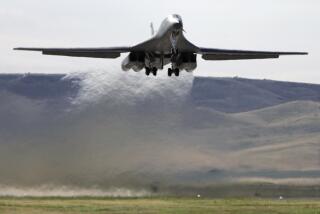After $1 billion is spent to address nuclear scandals, Defense secretary says there’s more to be done
Reporting from Minot Air Force Base, N.D. — Two years after an embarrassing series of scandals swept this remote Air Force base, the only home to both B-52 bombers and nuclear-tipped Minuteman III missiles, Defense Secretary Ashton Carter flew in Monday to take stock.
The Pentagon spent $1 billion to upgrade conditions here and at other bases after discovery of rampant drug use, poor leadership and widespread test cheating led to dismissal of dozens of launch officers.
Much of the money went for better equipment, from maintenance trucks to the elevators that officers take to command posts in underground facilities known as capsules. It also paid for deep cleaning the capsules for the first time since they were built in 1962.
The overhaul has improved security and morale for the launch officers, known as missileers, Air Force officials said. But Carter said more needs to be done.
“I realize it feels at times that most people don’t often think about your mission, which I know can be frustrating,” Carter told airmen in front of a B-52 carrying six cruise missiles.
“We’re now beginning the process of correcting decades of under-investment in nuclear deterrence – and I do mean decades, because it dates back to the end of the Cold War, when funding for the enterprise dropped,” he said.
The Pentagon released a 60-page report in November 2014 that detailed problems in the nation’s nuclear force. It singled out Minot as a “special case” for attention.
Isolated on the windswept and often frozen plains of northern North Dakota, Minot is the only U.S. base with intercontinental ballistic missiles and nuclear-capable bombers, two legs of the so-called nuclear triad. Submarines that carry ballistic missiles are the third leg of the triad.
The Pentagon has proposed a $348-billion plan to upgrade the nuclear arsenal, including the bombers, missiles and subs. The next president and Congress will decide whether the nation needs and can afford that.
The Pentagon has begun the decade-long process of developing a new stealth bomber, dubbed the B-21 Raider, and replacing the Ohio-class ballistic missile submarine. The Air Force last month started initial assessments of a new intercontinental ballistic missile.
In his speech, Carter cited Russia’s “nuclear saber-rattling and building of new nuclear weapons systems,” as well as North Korea’s recent nuclear and missile tests, to justify the new weapons.
“In today’s security environment – one that’s dramatically different from the last generation, and certainly the generation before that – we face a nuclear landscape that continues to pose challenges, and that continues to evolve … in some ways less predictably than during the Cold War,” he said.
The missileers in Minot’s 15 capsules command 150 nuclear-tipped missiles that are housed in underground silos several miles away. Much of the equipment is showing its age.
“It’s all stuff from the 1960s,” said Maj. Matthew Adams, 35, who was on alert in one of the underground missile control centers.
“There’s structural fatigue on engines and concrete bunkers,” said John Noonan, a former Minuteman III launch officer who is now a national security analyst. “These have all been neglected for a quarter-century, and we’re fast approaching crisis mode.”
Stepping inside the razor-wire fence along the perimeter at Minot is like stepping back to the Cold War.
Massive B-52 bombers regularly rumble into the sky while missile officers down in the capsules are supposed to launch a nuclear attack at a moment’s notice.
“We’re still on the same level of alert that we were on during the Cold War,” said Lt. Col. Jared Nelson, commander of the 742nd missile squadron, nicknamed the Wolfpack. “I don’t think people understand that.”
That’s one reason morale remains a problem.
Most missileers are assigned the job out of military school. It is seen as tedious work, sitting 24 hours at a time below ground, breathing recycled air and dealing with aging technology.
“The career field will never attract many volunteers because of its reputation as a backwater that produces few generals, and as a force without a future,” said Bruce Blair, a former ICBM missileer and founder of Global Zero, a group that seeks elimination of nuclear weapons.
To give more authority to the head of the Air Force nuclear force, known as Global Strike Command, the Pentagon recently chose a four-star general for the first time. But the new commander, Gen. Robin Rand, has a background as a pilot, not a missileer.
“The pick spoke volumes about the dominance of fly-boys over missileers and represented yet another slight,” Blair said.
The Air Force also changed policies under which missileers thought they needed to score 100% on tests they take three times a month or they would be blocked from promotion.
The 2014 Pentagon study deemed the “culture of perfection” a contributing factor in the cheating scandal, which came to light after an investigation into drug use among missileers turned up text messages with test answers.
The missileer tests are now pass-fail and are called a learning exercise.
Stephen Schwartz, a nuclear weapons policy expert and the coauthor of “Atomic Audit,” which assesses the costs of the U.S. nuclear weapons program, said the reforms haven’t fixed the underlying problems.
“The skills of a missileer are not readily applicable to the civilian sector, let alone to other military professions,” he said.
Twitter: @wjhenn
ALSO
The Cold War saw decades of nuclear deterrence. What happens when a rogue state gets the bomb?
Nuclear accident in New Mexico ranks among the costliest in U.S. history
How two police shootings of black men sent Tulsa and Charlotte in different directions
More to Read
Sign up for Essential California
The most important California stories and recommendations in your inbox every morning.
You may occasionally receive promotional content from the Los Angeles Times.











